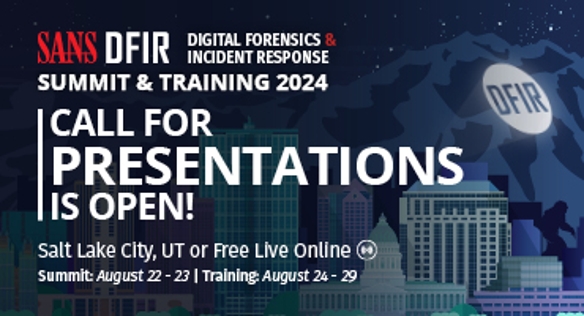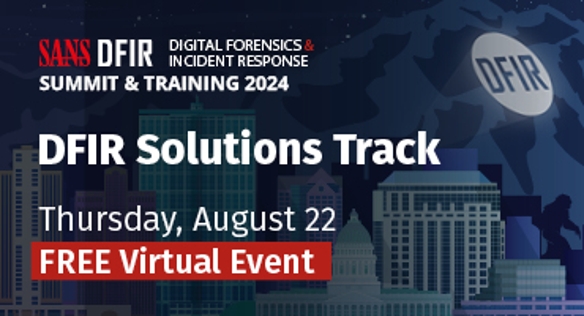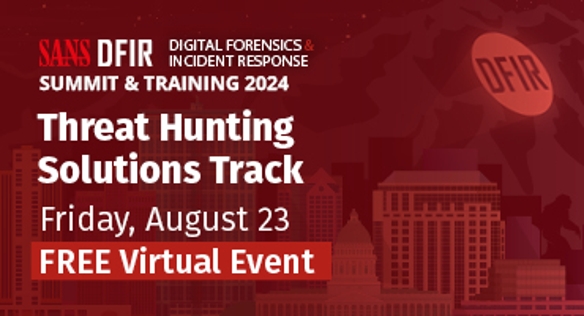SANS DFIR Summit & Training is moving to Salt Lake City!
Summit: August 22-23 | Training: August 24-29 | Summit CPE Credits: 12
Salt Lake City, UT & Free Live Online
Summit Co-Chairs: Heather Mahalik & Phil Hagen
Call for Presentations is Open!
“Every talk has a little nugget that you can add to your forensic toolbox no matter what your forensic wheelhouse may be. This is a must-attend event.” - A. Sparling

Every year, forensic and incident response professionals from around the world attend the SANS DFIR Summit to learn how to overcome their latest obstacles, hear about the latest open-source forensic tools, share methods and strategies proven effective in their investigations, and connect with the top DFIR practitioners in the industry.
The knowledge shared over just two days is enough to last the entire year. Whether this is your first or sixteenth DFIR Summit, you’ll be joining a community that is driven by the search for truth in digital forensics and eradicating adversaries from their target environment through incident response engagements.
Ask any of the returning attendees - a key benefit is that you’ll have the opportunity to network with other like-minded DFIR professionals. If you work in digital forensics or incident response, the SANS DFIR Summit is the must-attend event of the year.
Choose Your Summit Experience:
In-Person - All Access | Free Live Online - Select Content
Join us in Salt Lake City, Utah for the full Summit experience. The $425 In-Person Summit Registration Fee Includes:
- Two Full Days of Highly Technical Content - The industry's top practitioners will share their latest digital forensics and incident response research, solutions, tools, and case studies. In-Person attendees get access to all Keynotes, Summit talks, breakout sessions and workshops.
- Exclusive Networking Opportunities with the top-minds in DFIR - You'll have the chance to engage with leading experts, SANS instructors, and your peers in the community. Attendees tell us time and again that one of the greatest takeaways from SANS Summits is the many industry connections they forge or deepen during their time with us.
Access to Exhibit Hall
Evening Social Events
SANS DFIR Merchandise and Posters
Food! 2 Days of Breakfasts, Lunches, and Snacks
First-Access to Recordings and Presentations
Top 5 Reasons We Chose Salt Lake City
- Close proximity to the mountains. It's easy to experience the outdoors since you’re close to a number of mountains, ski areas and their Summer activities, and national parks. SLC is the gateway to five of America's most popular National Parks: Zion, Arches, Canyonlands, Capital Reef, and Bryce Canyon.
- There has been an explosion of development in the last 10 years. Provo, UT (just 45 miles away from the hotel), is ranked #3 on the list of Top 10 up-and-coming Tech Hubs.
- The brewery scene is impressive. For a town that once had strict liquor laws, they've been loosening the rules since 2000 and the bars popping up are really fun.
- The airport offers easy access to/from the majority of the country - over 90 nonstop destinations.
- The weather is going to be much nicer than Austin in August - Need we say more?
You can read more about all the nearby amenities here.

Live Online Attendees Will Have Access to:
- Select Talks and Content - The industry's top practitioners will share their latest digital forensics and incident response research, solutions, tools, and case studies.
SANS DFIR Summit Solutions Track | Thursday, August 22 | Chaired by Jason Jordaan | Register Here - This track will explore some of the cutting-edge tools and solutions available to help you in your fight against cybercrime.
- SANS DFIR Summit Threat Hunting Track | Friday, August 23 | Chaired by: Domenica Crognale | Register Here - This track will arm analysts with knowledge of the latest attack trends, research into the artifacts, and insights into multiple tools and techniques that will assist in the timely incident response necessary to keep your business or organization safe and functioning.
Interactive Chat on Slack – Connect with your DFIR community
First-Access to Recordings and Presentations - You'll receive exclusive access to approved recordings and presentations post-Summit.
What Attendees Say
"The DFIR Summit never disappoints and is still the #1 DFIR event. As a leader, it allows me to keep a pulse on cutting-edge research and to meet folks." - Brad Garnett
“I think this is the very best event in the DFIR Community, bar none. The combination of the best networking opportunities and the world's best instructors and content can't be beat.“ - John McCash

Bundle Your Summit Experience with a SANS DFIR Course
Enhance your knowledge base and add to your toolkit with a hands-on, immersive course taught by top SANS instructors and course authors. This year we're featuring 13 Top SANS DFIR courses
Sponsorship Opportunities
Sponsorship opportunities are currently available for SANS DFIR Summit & Training 2024. If your organization would be interested in sponsoring, please reach out to sponsorships@sans.org for more information.
.jpg?auto=webp&height=390&crop=3:1)























